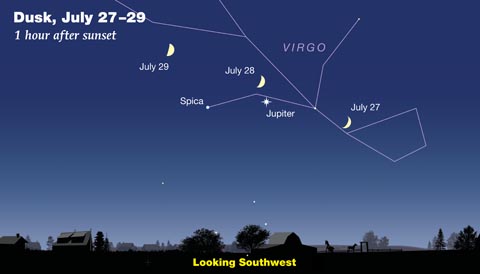Jupiter and Saturn are easy to spot in the evening sky, as you'll discover in July's fun and informative astronomy podcast.
July is a time of warm — and short — summer nights for northern observers. This month you'll find the solar system's two largest planets, Jupiter and Saturn, forming a pair of "celestial bookends" in the evening sky.

Sky & Telescope
The one on the right, over in the southwest, is Jupiter, which has dominated the evening sky for several months. But it's creeping toward the sunset point, means that Jupiter's reign is slowly coming to an end.
Well to the left of due south, is Saturn, our solar system’s second-largest planet. In contrast to Jupiter’s slow disappearing act, Saturn is ascending in the evening sky. It was at what’s called opposition, directly opposite the Sun in the sky, back in mid-June. And ever since this beautiful planet has inched a little higher in the sky at sunset.
These two planets serve as a easy-to-find guideposts for locating other stars and constellations, such as Scorpius, Sagittarius, and Virgo. To learn more, listen to or download our monthly astronomy podcast below. It provides a 8-minute-long tour of the stars and planets that you'll see this month.
Podcast: Play in new window | Download
Subscribe: Apple Podcasts | Google Podcasts | Spotify | Email | RSS | More
 1
1
Comments
Red3
July 30, 2017 at 12:05 pm
Hi, I would like to know about Comet 67P tracking information and the location of the Comet 67P on Sept 23, 2017, and the relationship to the Earth Orbit and the constellation of Virgo formation. Thank you, John
You must be logged in to post a comment.
You must be logged in to post a comment.